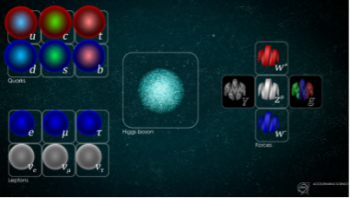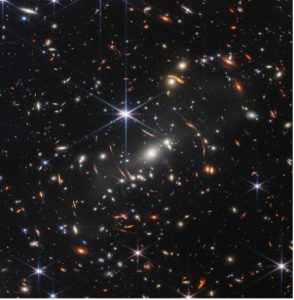By Vidya Rajan, Columnist, The Times
 The Big Bang was an explosion of immense power at a point in space about 13.7 billion years ago; the singularity from which everything in this universe – energy, space, time, matter – originated. Consensus on the universe’s origins from a fiery explosion emerged because of one incontrovertible signature that it left behind: a little bit of the heat from the fiery explosion that permeates all space evenly. It is called the cosmic microwave background radiation (CMBR), which heats interstellar space to 3K (-270.15oC) and is spread everywhere evenly, no matter where one looks. It could only mean all the universe was once a single point, and this origin story has been accepted since 1965, when CMBR was discovered. 1/1037th of a second (1/0.0,000,000,000,000,000,000,000,000,000,000,000,001th of a second!) after the Big Bang was the hypothesized “inflationary period” where the universe dispersed its explosive energy by going from the size of a proton to the size of a football (about a 1,000,000,000,000,000-fold – 1 quadrillion fold expansion).
The Big Bang was an explosion of immense power at a point in space about 13.7 billion years ago; the singularity from which everything in this universe – energy, space, time, matter – originated. Consensus on the universe’s origins from a fiery explosion emerged because of one incontrovertible signature that it left behind: a little bit of the heat from the fiery explosion that permeates all space evenly. It is called the cosmic microwave background radiation (CMBR), which heats interstellar space to 3K (-270.15oC) and is spread everywhere evenly, no matter where one looks. It could only mean all the universe was once a single point, and this origin story has been accepted since 1965, when CMBR was discovered. 1/1037th of a second (1/0.0,000,000,000,000,000,000,000,000,000,000,000,001th of a second!) after the Big Bang was the hypothesized “inflationary period” where the universe dispersed its explosive energy by going from the size of a proton to the size of a football (about a 1,000,000,000,000,000-fold – 1 quadrillion fold expansion).
One of the big head-scratchers is whether other universes were also created at the same time as our own universe. The way I visualize it is to imagine a soap bubble emerging from a wand: Was it a single large bubble or many bubbles that were formed. But there is no clear answer about whether we are in a single universe, or if there are universes of different sizes all over the place. Then to the shape of the universe, which seems to have undergone initial inflation rapidly, but then settled to long-term expansion. Currently there are three views of the shape of the universe based on the difference in the density of the universe. If gravity is high, the universe will shape itself into a ball. This is unlikely, given that the universe is expanding. If the density is low, space will warp negatively, making a saddle. Finally, as seems “most plausible”, the universe has the perfect density of six protons/1.3 cubic yards, making it expand evenly without warping. This gives us a flat universe.[1] This is not as odd as it feels. Imagine the two parallel lines extending out. If they meet, the universe is spherical; if they diverge, it is saddle shaped; if they remain parallel, the universe is flat. For more information on this perplexing structure, please see Physics Girl’s explanatory video at https://youtu.be/MTUsOWtxKKA?si=kOuN-YBTVpvvDe

Figure 1: Left: Alternative visions of the structure of our universe as a unique entity, or as one of many universes in a multiverse. Created using AI drawing platform Craiyon.com. Right: Possible shapes of the universe. Top: sphere; middle: saddle-shaped; bottom: flat. The current view is that the universe is flat because its density is optimal, giving it net zero energy.
Experimentation has told astronomers much about the events following the Big Bang. From the instant of the Big Bang to about 100 seconds after it, in the Radiation Era, some energy transformed into particles of matter. (Einstein’s e=mC2 governs this transformation and it is also the principle by which smashing particles in colliders releases enormous energy which causes new particles to be formed.) From 101 seconds after the Big Bang to the present is called the Matter Era. It is the time period during which matter formed from the organization of subatomic particles into atoms and then molecules, forming all the stuff in the universe.
Sophisticated telescopes can look back in time for light dating from the explosion. But the very existence of the explosion creates an “event horizon” which cannot be penetrated. To the questions arising: Are there other universes beyond ours? Or is there only an endless vacuum? are unanswerable. So, let’s shift our gaze back to our own universe, because it, too, has plenty of unanswered questions. For starters, when astrophysicists add up the mass of all galaxies, stars, dust, comets and planets, they find it only accounts for about 5% of the total. About 25% is thought to be what is called “dark matter”, because it does not radiate light, but does show gravitational influence, for example, by affecting the movement of light. The remaining approximately 70% cannot be seen or sensed by any of the apparatus we can use to detect light, heat, sound or radiation. This stuff is termed “dark energy”. It is only known to exist because it is pushing matter in the universe further apart at an incredible rate of about 73.3 kilometers per second, leading to the famous “red shift”, where light from stars stretches into the red wavelength as they move away, like the wail from a siren as it recedes in the distance. (It cannot be dark matter, because its gravity would pull matter closer together.)
Here is a visual to put it all in perspective:

Figure 2: The composition of the universe: ~70% dark energy; ~25% dark matter; ~5% matter
Matter is essentially a solid form of energy and came into existence around 1 second after the Big Bang. Since the universe was so hot, subatomic particles just milled around for another 99 seconds until the first elements, hydrogen and helium were formed. Matter also has a mirror-image, called antimatter. [2] When the two come into contact, they annihilate and produce a burst of energy. By a quirk, though, more matter particles are present than are antimatter particles, so our matter-made universe exists. Had there been equal amounts of both matter and antimatter, they would have canceled each other out. Although it only accounts for 1/109 particles more of matter than antimatter, this adds up to make all the matter particles that we can observe and is as yet unexplained.[3]
The current understanding of the nature of the universe is based on a theory called the “Standard Model”, which is supported by experimental evidence obtained by smashing particles in colliders. This model is considered the most successful of all theories to date and it posted a major hurrah in 2012 when the Large Hadron Collider in Geneva found a particle that was predicted by Peter Higgs in 1964[4], and therefore called the Higgs boson. The Standard Model posits the presence of the “fundamental” building blocks of the universe: 6 matter particles called leptons, 6 matter particles called quarks (which come in “flavors” called up, down, charm, strange, top and bottom). Finally, there are force carriers called bosons (gluon, photon and the three related bosons called W+, W–, Z0) that mediate matter particle interactions. Finally, there is the Higgs boson, a force carrier that confers mass on particles that interact with it. [5]

Figure 3: The Standard Model containing the fundamental building blocks of matter and force in the universe.[6] Quarks come in “colors” (u=up; d=down; c=charm; s=strange; t=top; b=bottom). The term ”quark“ comes from James Joyce’s novel, Finnegan’s Wake, and was adopted by Murray Gell-Mann because quarks come in three pairs.
There are four fundamental forces in the universe that control the actions of matter. In order of decreasing strength, they are: 1. The strong nuclear force is mediated by gluons (g) which “glue” quarks together in various combinations to make protons or neutrons. This is the energy that makes the atom bomb so powerful; 2. Electromagnetism is 1/100th of the strength of the strong nuclear force. It is due to the attraction of opposite charges or poles. Its force carrier is the photon (γ); 3. The weak nuclear force which is carried by electrically charged W+ and W– bosons and neutral Z0 bosons. It is this force that allows some particles to escape the nucleus as what we call alpha- and beta- radiation; and 4. Gravity, whose operation at the atomic (quantum) level is a mystery. At the large-scale level, Einstein showed that gravity is due to a warping of space-time. Scientists have posited particles called “gravitons” but haven’t found any. Yet.
In this article, I had hoped to put the “fun” back into the fundamentals of the structure and function of the universe. Rather, I may have inadvertently put in the “mental”, as in, “the universe is crazy”. But it is undeniably fun to look up and consider that so much exists beyond the 5% that is visible.
Let me end with the first image sent by the newly launched James Webb telescope, which was peering back in time to about 4.6 billion years ago, when our solar system was just forming. This image of the universe shown in Figure 4 covers the space equivalent of a grain of sand held at arm’s length. So, yes, this means that the universe is very, very big. And so very, very, beautiful. To solve the mystery of how it came to be means so much. Darwin said, in On the Origin of Species: There is a grandeur in this view of life, with its several powers, having been originally breathed into a few forms or into one; and that, whilst this planet has gone cycling on according to the fixed law of gravity, from so simple a beginning endless forms most beautiful and most wonderful have been, and are being, evolved. This statement could also apply to our understanding of the universe we live in, and we are still just learning about that beginning.

Figure 4: NASA’s James Webb Space Telescope has produced the deepest and sharpest infrared image of the distant universe to date. Known as Webb’s First Deep Field, this image of galaxy cluster SMACS 0723 is overflowing with detail.[7]
[1]. Cottier, C. (2021). What shape is the universe? [online] Astronomy Magazine. Available at: https://www.astronomy.com/science/what-shape-is-the-universe/.
[2]. Marco Gersabeck (2019). The Conversation Why Is There More Matter Than Antimatter? [online] Scientific American. Available at: https://www.scientificamerican.com/article/why-is-there-more-matter-than-antimatter/.
[3]. CERN (2019). The matter-antimatter asymmetry problem | CERN. [online]. Available at: https://home.cern/science/physics/matter-antimatter-asymmetry-problem.
[4]. Peter Higgs passed away as I was writing this article, on April 8, 2024. He was 94 and lived to see his prediction from 1964 of the last remaining piece of the Standard Model validated by the Large Hadron Collider in 2012. For this, Higgs, along with François Englert, won the Physics Nobel Prize in 2013.
[5]. Wikipedia Contributors (2019). Boson. [online] Wikipedia. Available at: https://en.wikipedia.org/wiki/Boson.
[6]. CERN (2019). The Standard Model. [online]. Available at: https://home.cern/science/physics/standard-model.
[7]. Anon, (n.d.). NASA’s Webb Delivers Deepest Infrared Image of Universe Yet – NASA. [online] Available at: https://www.nasa.gov/image-article/nasas-webb-delivers-deepest-infrared-image-of-universe-yet/.






